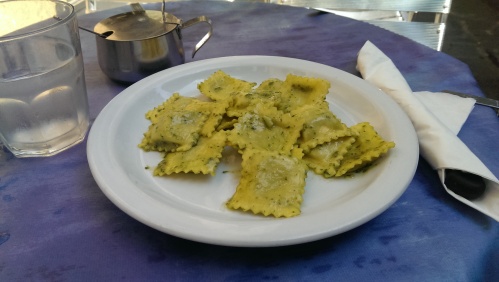I was in The Hill in St. Louis recently — that’s the really amazing Italian neighborhood in the city. Had lunch there twice, actually, and it brought back memories of my trip to Florence.

I then remembered that I started working on a post a while back, but never quite finished. An equation for ravioli. Here it is:
Looks a little complicated, but here is what you get when you graph it:

Yep, ravioli! So I thought I’d talk about how I came up with The Ravioli Equation. Not very deep, but there are a few interesting mathematical tidbits hiding in it.
Let’s look at the central mound — the curve which outlines all the deliciously stuffed goodness in the ravioli. I note that the ravioli in the picture above has a sauce of nuts and sage in butter, but I don’t capture that in the equation….
This is an example of a superellipse, which is a generalization of the ellipse. It has equation
where a and b are positive numbers. Of course when you get an ordinary ellipse, but for different n, you get other curves.
The parameters a and b are called semi-diameters of the superellipse, much like the semi-axes of an ellipse. Because ravioli are basically square, I set so that the superellipse equation looks like
Below are a few examples with a = 1 and n being 1/2, 2, and 4 (from left to right).

So you can see that the larger n gets, the more the superellipse looks like a square. I thought that a value of n = 6 looked just about right for ravioli.

Because I wanted the outer edge of the ravioli to have a radius of approximately 1, I used a value of a = 0.7 for the inner mound.
I should say a few words about using polar coordinates. Since superellipses are easily described with Cartesian coordinates, why bother to convert to polar? Well, I needed to get the scalloped ravioli edge. To show a simple example, consider a plot of the polar function
Here’s what it looks like:

Notice how adding the additional cosine term to r makes the circle “oscillate” as moves around the circle. Also notice how the coefficient of
tells you how many scallops there are around the edge.
This is a fairly simple way to produce something that looks like the edges of ravioli, so I decided to use polar coordinates for everything. Of course you remember the conversion, based on the definition of sine and cosine:
Substituting into the superellipse equation gives
and solving for r results in
And of course when n is even, the absolute value signs aren’t necessary. So this gives the equation for the inner mound as
Now let’s move on to the outer, scalloped edge of the ravioli. Let’s first look at the following polar function, which is basically a superellipse with some scalloping:
It looks like this (graphed together with the inner mound):

You can see the way the scalloping is modified when using a superellipse rather than a circle. But in my mind, ravioli edges are a bit more “crinkly” than this. The outer edges of the ravioli were just too smooth.
But there’s a nice fix. It comes from the fact that the arccos (I prefer this notation for the inverse cosine function, since an exponent of -1 can be ambiguous) function is really not an inverse of the cosine function, since the graph of the cosine function fails the horizontal line test. So we consider the domain of the arccos function to be and the range to be
In this case, the graph
looks like the line on the interval
But on the interval
the function
looks like

Now it should be clear that this function must be periodic with period But what is happening on the interval
? In this case, x is in quadrants III and IV. Since the range of
is
we’ve got to flip x over the x-axis — in other words,
You can see that this is the correct equation for the graph on the interval Add in the periodicity, and there you have it!
Using this new function adds the crinkliness to the ravioli edge. Delicious!
And for the final equation, we note that if we would like to simultaneously graph and
we simply graph the equation
So there it is — The Ravioli Equation! Of course you can change the parameters around to suit your particular taste in pasta. And you can even fiddle with how the corners of your ravioli look. Using sine rather than cosine, the equation
produces the ravioli below.

Does it look tastier than the cosine version? Hard to decide….
I hope you’ve enjoyed this introduction to the art of mathematical pasta making! It’s a fun activity, and definitely stimulates the appetite…. If you need some practice, here’s another fabulous dish of ravioli I had in Florence. Make it! Mathematically, of course…

Buon appetito!
I recently found out about Squircle [https://en.wikipedia.org/wiki/Squircle]. Looks like a=4!
LikeLike
Yes, it’s similar! The differences between the graphs for close values of n are less noticeable the larger n gets.
LikeLike
the very first time your blog has ever made me hungry
LikeLike